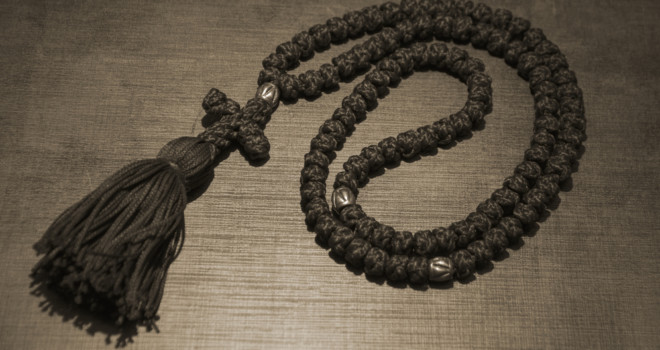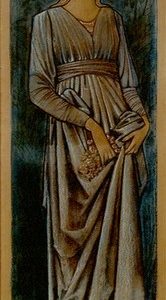The rosary takes fifteen minutes. Morning and evening prayer take maybe ten to twelve minutes each. The Divine Mercy Chaplet takes no more than seven minutes. Added up, I recently realized the sum total of my daily prayer life was only about forty-five minutes.
That didn’t settle very well with me. I wasn’t even giving God one hour of prayer each day? Something had to be done. And the remedy came in a set of prayer beads, but not in the form of our beloved rosary.
Referred to as “chotki” in Russian, or “komboskini” in Greek, a common name for these beaded or knotted devotional tools is the “prayer rope,” upon which the Jesus Prayer is prayed. Prayed by Christians before the sixth century, the Jesus Prayer varies slightly, but it is structurally based on Christ’s parable of the petition of the Publican who beats his breast and begs God for mercy, accusing himself as a sinful man.
The Jesus Prayer
The Jesus Prayer is “O Lord, Jesus Christ, Son of God, have mercy on me, a sinner.”
Albeit brief, this prayer does a number of important things. First, it recognizes and honors the Holy Name of Jesus. For those struggling with the sin of taking the Lord’s Name in vain, this prayer is a means of addressing that through loving reverence as opposed to disrespect.
Secondly, it identifies Jesus as the Lord, and, by association, Savior of the one praying. Thirdly, this prayer confesses Jesus Christ as the Son of God. Fourthly, and very importantly in this Jubilee Year, the prayer begs for mercy by confessing our sinfulness. The Jesus Prayer on the lips of the dying who are breathing out their last prayers is powerful, indeed. Which means it is a prayer of mercy for all of us.
A chotki may commonly have 33, 50 or up to 100 knotted cords or beads. The knots can be tied into complicated knots. It takes somewhere between 2-6 hours to tie a knotted chotki. Some monks have chotkis with 500 knots or cords. Some come with little tassels on the end, purportedly used by some to wipe away their tears of either penitence or joy.
One story from antiquity tells of a monk who used to tie simply knotted chotkis and then a demon who would untie the knots to frustrate the monk and suppress the devotion. As the story goes, his guardian angel appeared to the monk and taught him how to tie the knots in the form of a cross. The demon was unable to untie the knots from then on.
Chotkis are largely recognized as the prayer beads used by Eastern Rite Catholics as well as Eastern Orthodox, from whom the Latin Rite split by the eleventh century. But that means Christians were praying the Jesus Prayer for five hundred or more years preceding the Great Schism. And whereas Eastern Rite or Eastern Orthodox typically don’t pray the rosary, we Roman Catholics typically don’t pray with the chotki. But in asking why that is the case, a number of interesting factors came to light.
Pope Francis has been photographed wearing a chotki on his left wrist, traditionally, the preferred wrist for this devotion in the east. This way it keeps the right hand free to make the frequent Sign of the Cross in the Orthodox tradition. Additionally, Pope Francis has concelebrated the Eastern Rite Divine Liturgy as Archbishop Jorge Mario Bergolio. If he wears a chotki, he must, one would think, pray it. And why wouldn’t he pray it? It is scriptural. It is Christocentric. It is a prayer of both worship and petition. And it is a prayer of and for mercy.
My wife bought me a 100 bead chotki at our local Catholic book store. And I purchased another from St. Meinrad Monastery in Indiana. So if Roman Catholic institutions make chotkis available for purchase among the faithful, why wouldn’t we want to look into praying the Jesus Prayer with them?
The Jesus Prayer has been endorsed by St. John Chrysostom himself. Spiritual masters have advised praying this prayer constantly, dividing up the prayer in half with inhaling and exhaling. As we breathe in we pray, “O Lord, Jesus Christ, Son of God,” and as we breathe out we pray, “Have mercy on me, a sinner.” Ultimately, the goal is to make the Jesus Prayer “the prayer of the heart,” prayed throughout the waking hours of the day so often that it becomes psychologically present at all times. Some Greek Orthodox monks pray it 12,000 times each day.
It is an extraordinarily peaceful and meditative experience to increase the quality and quantity of one’s prayer life. And it is nothing to work up to praying the Jesus Prayer a couple hundred times every day.
Sure, I could pray an extra rosary, and sometimes I do. But several laps around the chotki give me the rich, prayerful fifteen minutes I was looking for.












